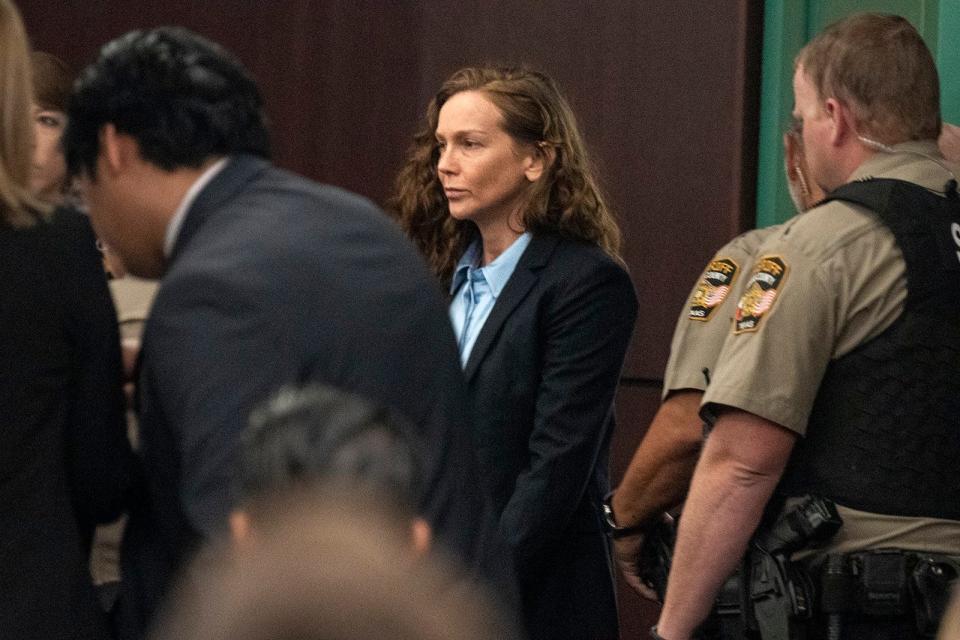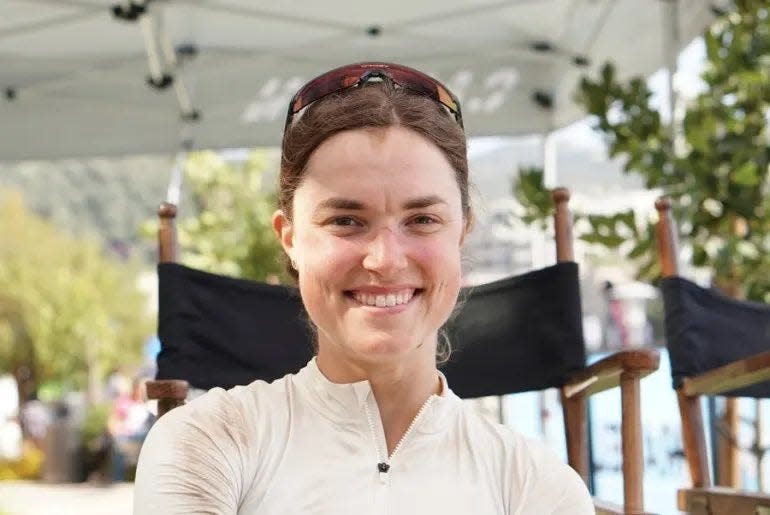Analyst: Kaitlin Armstrong's DNA found on Mo Wilson's bike, along with third person's
DNA from Kaitlin Armstrong and Anna Moriah "Mo" Wilson was found on the handlebars and seat of Wilson's bicycle, but so was the DNA of an unknown person, a state analyst testified Tuesday.
The DNA of an unknown third person also was found on Armstrong's gun, along with that of Armstrong and her former boyfriend, Colin Strickland, said Samantha Perkins, the supervisor of a Texas Department of Public Safety laboratory.
The testimony happened during the eighth day of the murder trial of Armstrong, who is accused of killing Wilson on May 11, 2022, in an East Austin garage apartment. Prosecutors have said Armstrong was jealous of Wilson's relationship with Strickland, and witnesses have testified Armstrong had talked about wanting to kill her.

Perkins also said the DNA from the unknown person found on the handlebars of Wilson's bike also included a Y chromosome, which comes from men. Perkins said the unknown third person in the DNA mixtures from the gun and the bike could not be identified as being from one person or three different people.
Defense lawyer Liz Duggan suggested the DNA from Armstrong found on Wilson's bike could have come from when Wilson borrowed Armstrong's motorcycle helmet. The defense has said Armstrong called Wilson on Oct. 28, 2021, because she thought Strickland had lent Armstrong's helmet to Wilson.
Perkins said DNA from a motorcycle helmet could be transferred to another object or person, but it would depend on several factors.
"When you look at DNA, it doesn't tell us when it was deposited," Duggan said to Perkins. Perkins agreed.
Prosecutor Ricky Jones later asked Perkins if the way a person could leave DNA on a bike was to touch it. Perkins agreed.
Duggan also asked Perkins if she performed any DNA tests on Strickland's gun or Armstrong's Jeep. Perkins said she did not because no evidence was submitted from them. Duggan also asked if police submitted any DNA samples from people other than Armstrong, Wilson, Strickland and Caitlin Cash. Perkins said they did not. Cash discovered Wilson after the cyclist was shot in Cash's apartment.
Perkins said the chance that the DNA from the handlebars of Wilson's bike could have come from someone not related to Armstrong was one in 49,000. The probability the DNA on the seat of Armstrong's bike could have come from individuals not related to Armstrong was one in 224 billion, Perkins said.
A Travis County deputy medical examiner also testified Tuesday that Wilson was shot four times. Earlier testimony said Wilson had three gunshot wounds with one bullet striking her hand, but Travis County Deputy Medical Examiner Bernadette DeRussy said the latter was a separate bullet wound.
One of the shots through Wilson's chest had what DeRussy called a "short" exit wound. Short exit wounds cause a wide, irregular abrasion because the top layer of skin is scraped away, DeRussy said.
Prosecutor Guillermo Gonzalez asked DeRussy if the short exit wound could have happened if a person was leaning against a wall or laying on the floor. "It could be," said DeRussy.
Wilson could have been trying to defend herself when the bullet hit her finger, DeRussy said.
DeRussy said she couldn't determine the distance at which the shots were fired. She said she found no soot or marks that would have indicated the gun was pressed against Armstrong's skin.
On Monday afternoon, Austin police forensics supervisor Steve Aston testified that the cartridge casings and two of the bullets gathered at the crime scene had tiny lines or striations similar those on casings and bullets that police fired from Armstrong's Sig Sauer 9 mm pistol.
More: Police witness: Kaitlin Armstrong's phone turned off hours before Mo Wilson killed
"Are you telling the jurors that those cartridges came from a Sig Sauer to the exclusion of every single pistol in the known world of Sig Sauers?" asked Gonzalez.
"That's not what I'm saying," said Aston. "To make that claim you have to compare that firearm to every firearm in the world."

Defense lawyer Geoffrey Puryear cross-examined Aston, asking him if he knew that an article in a journal published by the Association of Firearm and Tool Mark Examiners found a 51% similarity between cartridge casings shot from different types of guns.
Aston said he had not read the article but agreed that casings from two different types of guns could have an "accidental" reproduction of marks. Puryear also asked Aston if there was a minimal number of matching marks or striations he looked for when comparing bullets from a crime scene to bullets fired from a defendant's gun.
Aston said he didn't have a minimum number. "The conclusions we reach are subjective," he said. "We don't deal with numbers or statistics."
More: Murder trial for Kaitlin Armstrong, charged in death of Mo Wilson, to resume Monday
Puryear asked Aston if there was an error rate included in his findings on the case.
Aston said he had never calculated his error rate. "I am confident in my opinion in this case," he said. Aston said he also test-fired bullets from the gun that Strickland owned, a Springfield 9 mm pistol, and found that they didn't match those fired at the scene.
Wilson, 25, was a star in the cycling world of gravel racing. Strickland was a professional cyclist at the time Wilson died. They initially met at a race in September 2021, Strickland has said.
Armstrong and Strickland were living together and dating again in May 2022 when Wilson visited Austin from San Francisco to prepare for a bicycle race. Strickland and Wilson went out to swim and eat on the day she was killed, Strickland has testified. Police have said he dropped her off at the home where she was staying and went back to his South Austin house. He has not been accused of any wrongdoing in the case.
Videos from neighbors' cameras have shown a black SUV resembling Armstrong's vehicle in the area at the time before Wilson was killed. GPS data from Armstrong's Jeep showed the vehicle parked near the home where Wilson was staying about 30 minutes before she was killed, police have said. The GPS data also showed Armstrong's Jeep leaving the area a few minutes after Wilson was shot, according to police.
Police have said Armstrong fled to Costa Rica on May 18, 2022, using her sister's passport. Police arrested her on June 29, 2022, at a hostel in the Central American country.
Defense attorneys have said that no one ever saw Armstrong with Wilson. They also have said that no one saw anyone inside the black SUV in the neighbors' videos.
This article has been updated to reflect that it was Kaitlin Armstrong's motorcycle helmet that Moriah Wilson had used.
This article originally appeared on Austin American-Statesman: Analyst: DNA from Kaitlin Armstrong, 3rd person, on Mo Wilson's bike

